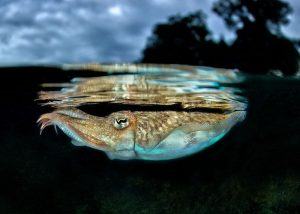Sara Reardon in Nature:
 Cuttlefish are masters at altering their appearance to blend into their surroundings. But the cephalopods can no longer hide their inner thoughts, thanks to a technique that infers a cuttlefish’s brain activity by tracking the ever-changing patterns on its skin. The findings, published in Nature on 17 October1, could help researchers to better understand how the brain controls behaviour. The cuttlefish (Sepia officinalis) camouflages itself by contracting the muscles around tiny, coloured skin cells called chromatophores. The cells come in several colours and act as pixels across the cuttlefish’s body, changing their size to alter the pattern on the animal’s skin. The cuttlefish doesn’t always conjure up an exact match for its background. It can also blanket itself in stripes, rings, mottles or other complex patterns to make itself less noticeable to predators. “On any background, especially a coral reef, it can’t look like a thousand things,” says Roger Hanlon, a cephalopod biologist at the Marine Biological Laboratory in Chicago, Illinois. “Camouflage is about deceiving the visual system.”
Cuttlefish are masters at altering their appearance to blend into their surroundings. But the cephalopods can no longer hide their inner thoughts, thanks to a technique that infers a cuttlefish’s brain activity by tracking the ever-changing patterns on its skin. The findings, published in Nature on 17 October1, could help researchers to better understand how the brain controls behaviour. The cuttlefish (Sepia officinalis) camouflages itself by contracting the muscles around tiny, coloured skin cells called chromatophores. The cells come in several colours and act as pixels across the cuttlefish’s body, changing their size to alter the pattern on the animal’s skin. The cuttlefish doesn’t always conjure up an exact match for its background. It can also blanket itself in stripes, rings, mottles or other complex patterns to make itself less noticeable to predators. “On any background, especially a coral reef, it can’t look like a thousand things,” says Roger Hanlon, a cephalopod biologist at the Marine Biological Laboratory in Chicago, Illinois. “Camouflage is about deceiving the visual system.”
To better understand how cuttlefish create these patterns across their bodies, neuroscientist Gilles Laurent at the Max Planck Institute for Brain Research in Frankfurt, Germany, and his collaborators built a system of 20 video cameras to film cuttlefish at 60 frames per second as they swam around their enclosures. The cameras captured the cuttlefish changing colour as they passed by backgrounds such as gravel or printed images that the researchers placed in the tanks. The recording began soon after the cuttlefish hatched, and continued for weeks. Laurent’s team developed video-processing techniques to identify tens of thousands of individual chromatophores on each cuttlefish, including cells that emerged as the animal grew larger over time. The team used statistical tools to determine how different chromatophores act in synchrony to change the animal’s overall skin patterns. Previous studies have shown that each chromatophore is controlled by multiple motor neurons that reach from the brain to muscles in the skin, and that each motor neuron controls several chromatophores. These in turn group together into larger motor systems that create patterns across the cuttlefish’s body.
More here.
